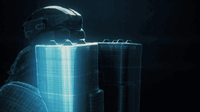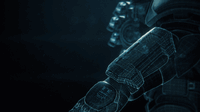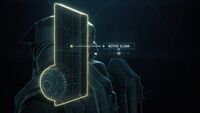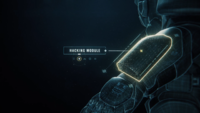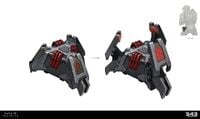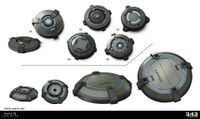Equipment
From Halopedia, the Halo wiki
Equipment is a type of special gameplay item introduced in Halo 3, featured in Halo 3: ODST as an enemy-only sandbox item, and again as a player-usable feature in Halo Infinite.
Overview[edit]
While prior Halo games featured power-ups in the form of overshield and active camouflage, these on-map pickups were activated immediately upon acquisition. Halo 3 introduced equipment as a new addition to the "golden triangle" of Halo gameplay alongside weapons, grenades and melee. Equipment can be found in campaign and multiplayer as pickups in the game world - once picked up, they can be activated at any time with a single button press.
Appearances[edit]
Halo 3[edit]
In Halo 3, equipment can be found in campaign and multiplayer modes. Equipment in Halo 3 are single-use pickups, and only one such item can be carried at a time. In the campaign, equipment can be employed by the player and by Brute AI enemies, with several equipment pieces reserved for the campaign not available in multiplayer. Most equipment can be found in multiplayer, placed on the map like any other power weapon. The mainstay list of equipment found in multiplayer includes the trip mine, bubble shield, deployable cover, flare, gravity lift, power drain, regenerator and radar jammer. The campaign features all the prior-listed equipment with the addition of the Invincibility, Cloaking and Auto-Turret. Later, in Halo: Reach, Halo 4, Halo: Spartan Assault, and Halo: Spartan Strike, equipment was remade into Armor abilities
The Invincibility equipment can only be found by killing Brute Chieftains, while the Cloaking can be found on the bodies of Stalkers and on the map in some areas. The Auto-Turret is exclusively found in a handful of levels and can only be used by the player. The Auto-Turret has since seen its addition to multiplayer with the release of Halo 3 on PC as part of Halo: The Master Chief Collection, and can now be spawned in Forge mode.
In Halo 3 Forge, equipment can be used to overload a map, allowing the player to escape the map's confines.
Halo 3: ODST[edit]
Almost all equipment - except for the gravity lift, auto-turret, regenerator and radar jammer - can be found again in Halo 3: ODST. Unlike Halo 3, equipment cannot be used by the player, and only exists within the game to be used by Brute enemies against the player.
Halo Infinite[edit]
Halo Infinite features the return of equipment pick-ups, with several abilities new to the series. The game's equipment includes the Grappleshot, Drop wall, Thruster, Repair Field, Repulsor, Threat Sensor, Threat Seeker, and Shroud Screen. In addition to these, overshield and active camouflage have also been melded into the equipment system, now called "power equipment." Like other equipment, both the overshield and active camouflage can be picked up and held, with the player being able to activate them on demand after a short animation. On top of the overshield and active camouflage, a third power equipment called the Quantum Translocator was also added. Unlike Halo 3, equipment use differs greatly between campaign and multiplayer. Four pieces of equipment in Halo Infinite can be equipped at once in campaign and recharge similar to armor abilities. This equipment can also be upgraded with Spartan cores.[1] In multiplayer matchmaking, only one piece of equipment can be used at a time, like in Halo 3, but retains multiple uses per pickup varying on game mode.[2]
Trivia[edit]

|
Browse more images in this article's gallery page. |
- In the January 2008 issue of EGM, in an interview with Brian Jarrard and Tyson Green, it was revealed that there was a piece of equipment cut from the final release of Halo 3 known as The Vortex. It was said to be deployed the same as a Power Drain, but would instead create a mini black hole that would "suck" in any object within range, and diverting its course into the black hole, and away from your face. It was even able to affect nearby objects such as the Fusion Coil and even other players. The design was cut due to the fact that it was too "expensive" from a networking and performance standpoint.[citation needed]
- In Halo 5: Guardians, there's a Type-54 plasma pistol variant named "Void's Tear" that works similarly to this cut piece of Equipment.
Gallery[edit]
Concept art of what appears to be an example of Banished equipment for Halo Infinite.
Sources[edit]
- ^ Halo Waypoint, Inside Infinite - February 2021 (Retrieved on Jun 1, 2020) [archive]
- ^ YouTube - HALO, #Ask343 Halo Infinite - Zeta Halo
| ||




